Designing a pilot remote and rural migration scheme: analysis and policy options
This report sets out analysis and policy options to inform a potential pilot scheme for migration to remote and rural areas of Scotland.
2. Economic and Social Context
Population decline can have a range of negative economic and social impacts on local communities, often contributing to a cycle of declining services and employment opportunities, which in turn triggers further out-migration. This chapter sets out some of the economic and labour market challenges for remote and rural areas created by population decline (2.1) and considers the distribution of incomes in these areas (2.2) and the impacts on public services and local communities (2.3). The chapter ends with a discussion of different approaches to identifying what we term 'designated areas': remote and rural areas facing population decline, which would potentially benefit from a remote and rural migration scheme (2.4).
2.1 Employment Patterns in Remote Rural Scotland
As we saw in Chapter 1, prolonged periods of natural decrease in population and low levels of in-migration result in a shrinking population and an ageing workforce. Such demographic change influences the balance of supply and demand in the local economy. It both restricts the local labour supply and leads to an increase in its average age. Population decline can also adversely affect public service provision, through creating labour shortages in key services. Moreover, government funding formulae for public services are largely population driven, implying that public services will receive less resource as people move away.
Labour markets in sparsely populated areas are particularly vulnerable to small fluctuations in labour supply. Here it is useful to distinguish between 'deep' and 'shallow' markets. Markets are described as deep when there are many buyers and sellers, which implies that the loss of a few buyers or sellers would make no material difference to the operation of the market. Labour markets in sparsely populated areas are, in contrast, extremely shallow. Small increases or decreases in labour supply can have large effects on the viability of the local economy. These effects may be amplified to the extent that households are dependent on both partners working. The loss of one job may cause both to emigrate to take up new employment opportunities. It may also cause a loss of children to the area who would form the future labour supply.
Nevertheless, those in remote rural areas are typically more economically active than those in the rest of Scotland, albeit by a small margin. Annual Population Survey data for 2017 shows that 81% of adults in remote rural areas between 16 and 64 were economically active, compared with 80% in accessible rural areas and only 77% in the rest of Scotland. With unemployment rates at around 4% (irrespective of geography), employment rates in the remote rural areas stood at 78%, therefore exceeding those in the rest of Scotland where they were 74%.
Remote rural areas are also characterised by more diverse employment patterns than elsewhere. Self-employment accounts for 23% of employment in remote rural areas, 18% in accessible rural and only 11% in the rest of Scotland. The proportion of the employed in remote rural areas with a second job, at 6%, was double the rate for the rest of Scotland. And the proportion working from their own homes comprised 24% in remote rural areas in 2017 compared with only 9% in the rest of Scotland. The share of those working from home rose dramatically during the pandemic: this was a working pattern with which residents of remote rural areas were already more familiar. It remains to be seen how much of the change in working patterns persists after the pandemic.
The occupational distribution of employment drawn from the 2017 Annual Population Survey shows that only around 11% of those living in remote rural areas belong to higher managerial and professional occupations, compared with 16% in the rest of Scotland. In contrast, 18% of those employed in the remote rural areas are small employers and own account workers. This compares with 14% in accessible rural areas and 8% in the rest of Scotland. Those living in Scotland's more remote areas are more likely to work on their own behalf, as 'solo self-employed'.
Another aspect of the fragility of the rural economy is its lack of diversification. The Scottish Government produces annual data on registered private sector businesses by the six-fold rural/urban classification. Registered businesses are those either registered for VAT (implying turnover over £85,000 as at March 2018) or for PAYE (employing others). In 2018, registered businesses accounted for 52% of the nearly 300,000 businesses operating in Scotland. Most agricultural businesses do register for VAT even if their turnover is less than £85,000, so that they can recover VAT on their input costs.
Figure 2.1 shows estimates of the share of enterprises, employment and turnover of those registered businesses located in Scotland's remote rural areas.[12] It clearly suggests that agriculture is the dominant sector in these areas. However, this may be misleading for the reasons alluded to above: Scotland has almost as many unregistered businesses as registered businesses. Unregistered businesses are likely to be relatively small and therefore disproportionately located in remote rural areas. Figure 2.2, which again reflects data on registered businesses, shows that even within this group, smaller businesses are overrepresented in Scotland's remote rural areas.[13] While 13% of employment in registered businesses in the rest of Scotland is accounted for by enterprises with between 0 and 9 employees, 37% of remote rural area employment falls within this type of business.
It is also noteworthy that remote rural areas have a substantially smaller share of employment (16%) in the public sector than is the case in the rest of Scotland (24%). This is likely to reflect lower representation of parts of the public sector where activity is centralised, such as hospitals, colleges, universities and administrative centres, which rarely have a presence in remote rural areas. Note that international recruitment in these parts of the public sector is not unusual: the public sector is more likely to have processes in place for such recruitment than would be the case among small rural enterprises.
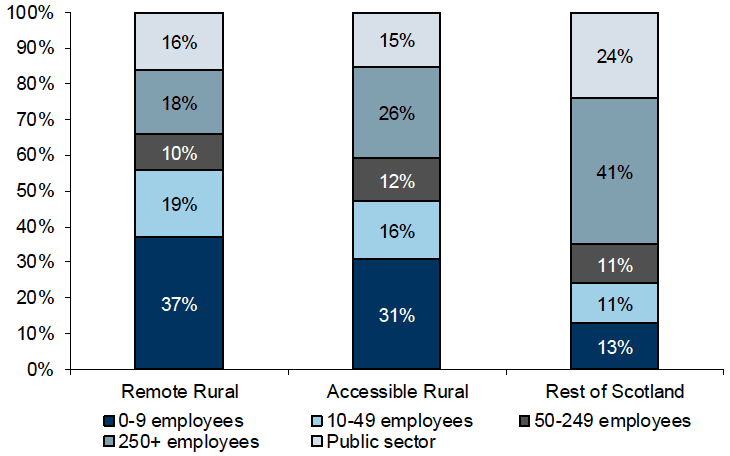
Source: Scottish Government Rural Scotland Key Facts 2018
Figure 2.2 shows estimates of employment in registered businesses in remote rural areas in 2017. Agriculture plays a more significant role in employing people in remote rural Scotland than in any of the other geographic zones, accounting for 39% of all Scottish registered enterprises in this sector. However, total employment in food and accommodation is almost the same as that in agriculture in registered businesses in remote rural areas. Food and accommodation has a much larger presence than agriculture in the rest of Scotland. This sector therefore represents a smaller share of total Scottish employment than does agriculture in remote rural areas.
Note that these estimates derive from a census carried out each March. They therefore do not capture seasonal variations in employment which are likely to be more pronounced in food and accommodation than in other sectors in remote rural Scotland. Agricultural employment in remote rural areas does not vary seasonally in the way that it does, say, in Tayside and Angus, where seasonal fruit picking causes large swings in employment. It is likely therefore that employment in food and accommodation substantially outstrips that in agriculture during the summer months. Employment in other sectors, such as professional and scientific services, administration, education and health is, as one would expect, relatively low and will remain so throughout the year.

Source: Scottish Government Businesses in Scotland 2019
Figure 2.1 showed that businesses in remote rural areas are typically smaller on average than those in the rest of Scotland. A different visualisation of the same theme is shown in Figure 2.3. It shows the number of businesses per thousand population by size of employment across Scotland is different in rural/urban geographies.[14] Remote rural Scotland has the largest representation of enterprises with no employees. Confirming the high levels of self-employment recorded in the Scottish Household Survey, these data show that there is a disproportionately high level of small-scale entrepreneurship in remote rural Scotland. Overall levels of employment are high, but the large share of self-employment may be a form of 'concealed unemployment' among the 'solo self-employed'. The Institute for Fiscal Studies[15] argues that this group typically earn less than average employees and that this wage gap has widened over time. Moreover, a large proportion of the solo self-employed are underemployed - they would prefer to work more hours, but there is insufficient demand to warrant extending their working time. Remote rural areas also have the highest share of enterprises with 1-4 employees.
Population decline can also adversely affect public service provision, through creating labour shortages in key services. Moreover, government funding formulae for public services are largely population driven, implying that public services will receive less resource as people move away, which can then further accelerate economic and population decline.
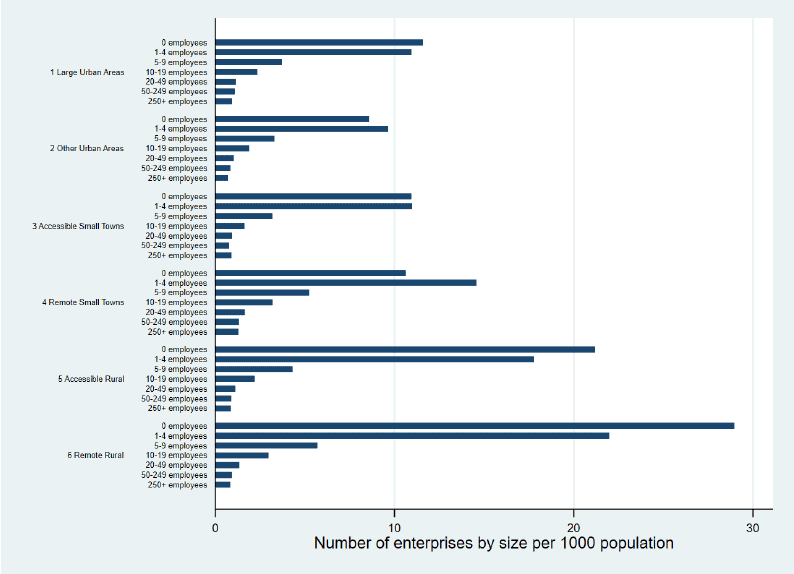
Source: Scottish Government Businesses in Scotland 2018
We found evidence of labour shortages in responses to the EAG survey conducted in 2019 for our report on internal migration in Scotland and the UK.[16] Local authorities in remote and rural areas noted difficulties for a range of employers in attracting and retaining suitably qualified staff. This was affecting both private and public sector employers, although the industries and kinds of vacancies most affected vary between areas. At a more local level still, local authorities, including both Shetland and Argyll and Bute, reported that within their area more remote communities or remotely located businesses, such as hotels or processing plants, struggled the most.[17]
Shetland Council's most recent employment survey, conducted in 2017, found that over 20% of employers reported difficulties with filling vacancies.[18] This issue was particularly acute in manufacturing (food and drink processing, engineering, textiles and crafts) and construction, but also affected public services. The Council noted long-term difficulties filling vacancies in health and social care and NHS Shetland's Workforce Plan Update 2019-2020 highlighted posts for consultants and senior nurses vacant for six months or more.[19] The Workforce Plan also notes augmented pressure on services due both to increased demand linked to ageing of the local population and to difficulties maintaining supply as the workforce ages. In certain specialisms ageing of the workforce is an acute concern: 53% of nurses and midwives for example are aged 45 and above and 40% are over 50 years old.[20] The report also notes that some services especially in more remote communities, rely on a single practitioner or specialist, making them particularly vulnerable.
Argyll and Bute also reported 'significant skills gaps and unfilled vacancies in areas such as health and social care, where demand is increasing as the population ages'.[21] Moreover, a 2019 survey of the tourism and food and drink industries revealed significant recruitment issues across both industries, with 40-50% of employers reporting difficulties filling posts either due to a lack of applicants or a lack of suitably skilled applicants. Senior managerial and operational roles were reported as particularly hard to fill and the tourism sector also specifically noted problems recruiting and retaining chefs, other kitchen and waiting staff.[22] Since those employees who were successfully recruited to and retained in such posts were often EU nationals, there were further concerns about how the end of free movement would exacerbate these trends.
These difficulties reflect the shallowness of the labour markets in remote rural areas. Employment rates are very high, but many are employed in small scale enterprises associated with agriculture or food and accommodation. There is no readily available pool of labour to fill vacancies in other sectors: such vacancies are therefore likely only to be met from migrants who must assess the costs of moving in respect of income, housing and movement costs and (possibly) partner's employment.
2.2 Incomes
We now consider incomes across remote rural areas of Scotland. This is important both for understanding the local economy, but also the potential to attract migrants to work in key sectors and occupations in remote and rural areas. Our main data source is the Annual Survey of Hours and Earnings (ASHE) collected by the Office for National Statistics provides accurate estimates of national employee earnings. However, for relatively small areas, mean or median annual earnings cannot be estimated precisely because sample sizes are relatively small.
Hourly earnings in remote rural Scotland are lower than in the rest of the country. ASHE data analysed by the Scottish Government shows median hourly pay (based on residence) is £12.95 in remote rural Scotland. This compares with £15.09 in accessible rural areas and £13.79 in the rest of Scotland (see Figure 2.4). Similar differences emerge for both males and females. However, this is largely a compositional effect. Median annual earnings for full-time workers in rural areas are around 3.3% less than those in the rest of Scotland, while hourly earnings for all employees lagged by 6.1%. The larger share of part-time employment in the remote areas explains the greater differential between earnings for all workers compared with those for full-time workers. Focussing on full-time wages for employees gives a very partial view of the remote rural labour market because full-time employees constitute a smaller proportion of the labour market than is the case for the rest of Scotland.

Source: Scottish Government, Rural Scotland Key Facts 2018
Median annual earnings for full-time employees in remote rural Scotland were estimated at £27,188 per annum in 2017. Although, as already noted, this estimate lies below that for the rest of Scotland, it suggests that more than half of all full-time employment in remote rural Scotland pays above the Skilled Worker route earnings threshold of £26,500 per annum. Data from the Scottish Household Survey suggest that the distribution of income in remote rural areas is closer to that of the rest of Scotland, then it is to Scotland's accessible rural communities. The most striking example is that while 22% of highest income householders in remote rural Scotland earned more than £40,000 per annum and the corresponding proportion for the rest of Scotland is 21%, the proportion earning more than £40,000 in accessible rural areas is 30%. High income householders in Scotland prefer to live in accessible rural areas rather than in urban centres or remote rural areas. Accessible rural is desirable for high earners who can commute to urban centres. The time and transport costs of accessing high-paying urban jobs from Scotland's remote rural areas has tended to be an almost insurmountable obstacle to this form of commuting. The pandemic may have changed this calculation somewhat, given the substantial increase in home working that it has caused.
The ASHE data can also be disaggregated by travel to work area (TTWA). TTWAs do not directly align with measures of rurality. Instead, TTWA boundaries are derived from commuting patterns: they capture areas within which 75% of journeys to work take place. This may be relevant for migration policy if these are employer-based without a residence requirement. Workers will seek accommodation within what they considered to be feasible travel to work distances, and these are more likely than not to be within the relevant TTWA (we discuss TTWAs further in 2.4).
Figure 2.5 shows median gross annual earnings for full-time employees in 2020 by Scottish TTWA. (More up-to-date earnings data is available on TTWAs from ASHE than on remote rural Scotland). It shows that for most TTWAs, median annual earnings are above the Skilled Worker route threshold of £26,500. Those were median earnings are below the threshold are concentrated in rural areas, though it is not easy to determine how far these overlap with our remote rural areas. However, where the median lies close to the threshold, migrants would not be eligible for around half of the full-time jobs available within the TTWA.
These data focus on full-time workers. Our earlier analysis shows that full-time work is less common in remote rural areas. Instead, part-time work, double jobbing and self-employment are much more common than in Scotland as a whole. These are manifestations of weakness in the local labour market and likely also to be a major cause of emigration from these areas.
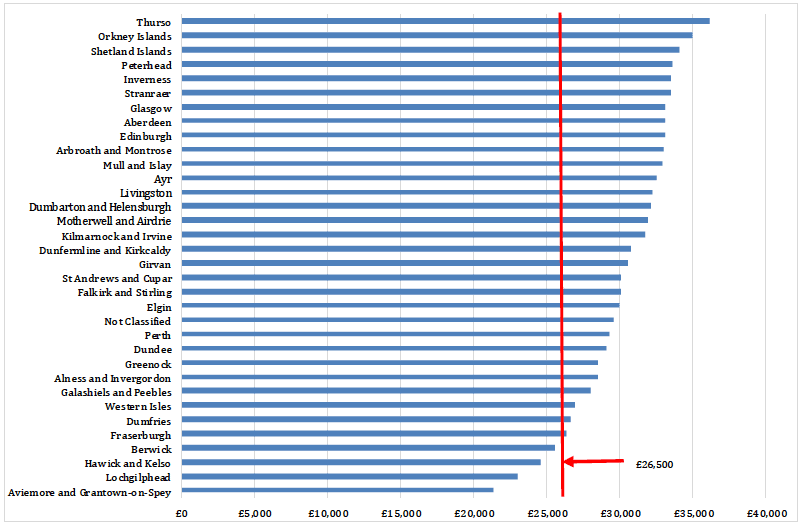
Source: Office for National Statistics Annual Survey of Hours and Earnings 2020
As we have already seen, agriculture is one of the two most important sectors in remote rural areas. It is heavily dependent on subsidy. Eligibility for subsidy is contingent on location. The most generous subsidies are available in 'Less Favoured Areas'. The map of these areas is shown in Figure 2.6.
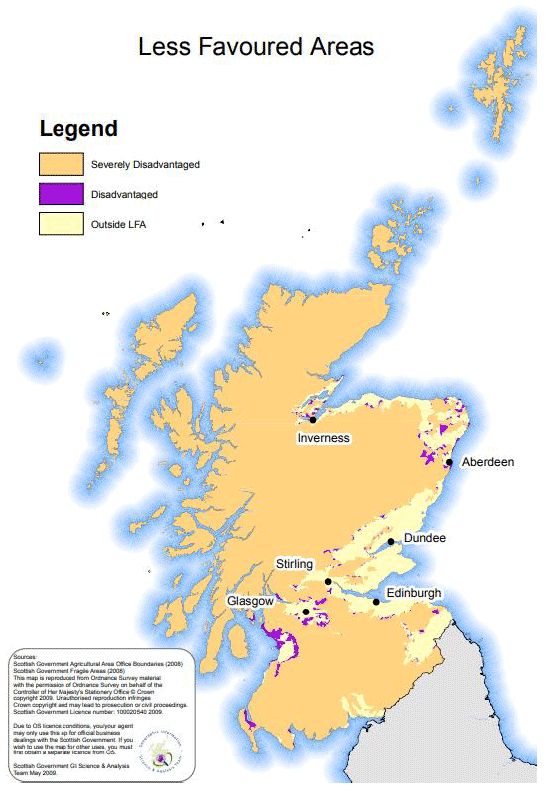
Source: Scottish Government, Less Favoured Areas 2009
LFAs cover much of rural Scotland, including remote rural areas. Payments to farm enterprises within LFAs have traditionally been paid through the Common Agricultural Policy. These comprise a major source of income for farmers in rural areas. Thus, in 2017-18, the average farm business income in LFAs for sheep farms was £18,231 while for cattle, it was £24,734. However, the CAP direct payment for sheep was £33,231 while that for cattle was £37,426: without direct payments from the EU, these businesses would not have been viable. Until the design of post-Brexit agricultural support in Scotland is clear, it is not possible to predict how the agriculture sector in remote rural Scotland will be affected.
These observations on the labour market and on incomes show that the health of labour markets in remote rural areas is much more tenuous than statistics on employment rates and unemployment might suggest. This makes it difficult to design appropriate policies for attracting international migrants. In employer-based schemes, the usual assumption is that the migrant is moving to a single full-time job. But, as we have seen, this working pattern is much less common in remote rural Scotland than in the rest of the Scottish economy. Instead, more flexible employment patterns are common. Indeed, some of these may be a form of disguised unemployment. In addition, enterprises in remote rural areas tend to be relatively small and there is a lower proportion of public sector employees than in urban Scotland.
Home Office proposals for Skilled Worker route entry are likely to substantially increase the costs of recruitment from EEA countries, which have provided the bulk of international migrants to remote areas during the last two decades. There may be a case for providing employers with finance and advice to support EEA recruitment, which will inevitably be a more costly recruitment process for employers in remote rural Scotland post-Brexit.
2.3 Social impacts
The shrinking and ageing of local populations also bring social impacts, some of which are knock-on effects of the labour shortages discussed above. In the broadest terms, a steadily declining and ageing population can simply make an area feel less attractive to remaining residents, and especially younger people, as others in their age group leave. As employers struggle to recruit and local economies become less buoyant, businesses may leave the area taking with them access to more attractive or better-paid jobs. As remaining residents age, commercial and leisure facilities and social services for younger people and families often decline making it less attractive for those age groups to stay, whether they are locally born or newer arrivals. In these ways a spiral effect is created.
As noted above, the impact on local service provision is not only felt in terms of an increased demand for services to support the older population, although this is an issue of considerable concern for local authorities. Health services such as midwifery and the general availability of local health care are also affected, and this has clear implications for the working age population. So too does the provision of other services, such as childcare for younger families, and educational opportunities for those with older children. In a '10 year plan to attract people to live, study, work and invest in Shetland' launched in 2018, the local authority notes problems with access to childcare especially in more remote communities on the island.[23] This is a major issue affecting both employability and retention of existing population and the ability to attract and retain newly arrived workers and their families.
A lack of affordable, well-maintained and suitably sized accommodation for young families and/or younger workers living in couples or alone is also mentioned as a concern in both the Shetland '10 year plan' and the Argyll and Bute workforce survey. Poor transport links between residential areas and places of employment, some of which are located in more remote areas (for example, hotels, distilleries, food processing plants), affect the quality of life and job satisfaction of workers. This can contribute to problems with recruiting and retaining workers, whether new to the area, or locally born.
It is important to understand these dynamics to inform the design of a potential migration scheme. Clearly, the negative socio-economic impacts of population decline creates a strong rationale for seeking to mitigate such decline through facilitating in-migration. At the same time, in order for such in-migration to be viable and lead to longer-term settlement, it is important to make sure there are sustainable employment opportunities and an attractive environment for migrants in the local area.
As suggested in the introduction, a rural and remote migration scheme should not seek to mitigate population decline through 'replacement migration'. Rather, the scheme should seek to recruit and retain individuals and families who have the skills, background and preferences that can best mitigate the negative social and economic impacts of population decline. The goal of the scheme should thus be focused on 'strategic mitigation', with the goal of providing skills and services that can best promote the well-being and sustainability of local communities. We discuss what such a scheme might look like in Chapter 3.
2.4 Identifying designated areas
Based on the analysis of the last two chapters, how might we identify which areas would participate in a RRMS? The last two chapters have identified which areas of Scotland face the most acute challenges in terms of population decline and ageing, and this chapter has explored some of the social and economic problems that these population trends create for local communities. Based on this analysis, we now consider which areas of Scotland might be the most in need of an RRMS - or, as we term it, might be identified as 'designated areas' for the purpose of the proposed scheme.
We saw in Chapter 1 that it is possible to produce a very granular breakdown of areas facing population decline. A second classification broke down areas according to remoteness (drive-time from larger settlements). And the third classification combined these two measurements to produce Sparsely Populated Areas (SPAs) - see Figure 1.2b in Chapter 1. However, these SPAs still represent relatively small areas, and do not necessarily capture the geographical units in which people work and live. Indeed, the 2011 Census revealed that of the 2.1 million people in Scotland who travel to work, 43% travel between 5 km and 30 km, while 8% travel 30 km or more.[24] The implication is that international migrants may be recruited to take up a job in an area facing demographic stress; but choose to reside in an area that is less challenged. In this way, the potential benefits to the more challenged community would be substantially diluted. There will also be enhanced risk of subsequent internal migration to reduce commuting costs, once any restrictions on place of work were lifted.
In order to capture the significance of commuting within such labour market areas, Coombe et al. (1986) developed an algorithm to define TTWAs in Great Britain. These TTWAs frequently span local authority boundaries, and one local authority may contain more than one TTWA. However, they offer a promising basis for defining 'designated areas' for an RRMS. They identify 'activity spaces' within which people are likely to spend most of their daily lives - working, attending school, accessing health services, shopping, using leisure facilities, socialising, and so on. In this sense, these areas would capture the range of activities that migrants are engaged with, which would be relevant to strategic mitigation in areas facing depopulation. We suggest that the RRMS should be designed to encompass such TTWAs.
If we choose TTWAs as the designated areas for the scheme, we then need to determine which of these areas face the most significant demographic challenges. Figure 2.7 below shows which proportion of the population of each TTWA lives in data-zones which: (a) are classified as 'remote rural' or 'remote small towns' (6-fold classification); and (b) lost, on average, 1% or more of their population annually since the year their population peaked.
In the TTWAs Dunoon and Rothesay, Lochgilphead and Oban (shaded dark red), more than 35% of the population live in remote data zones that have lost 1% or more of their population. For Orkney, Portree, Turriff and Banff, Pitlochry and Aberfeldy and Girvan (shaded pink), 30-35% of the population live in such zones. All the TTWAs in the northern part of Highland are shaded yellow (15-29%), together with Shetland and Newton Stewart.
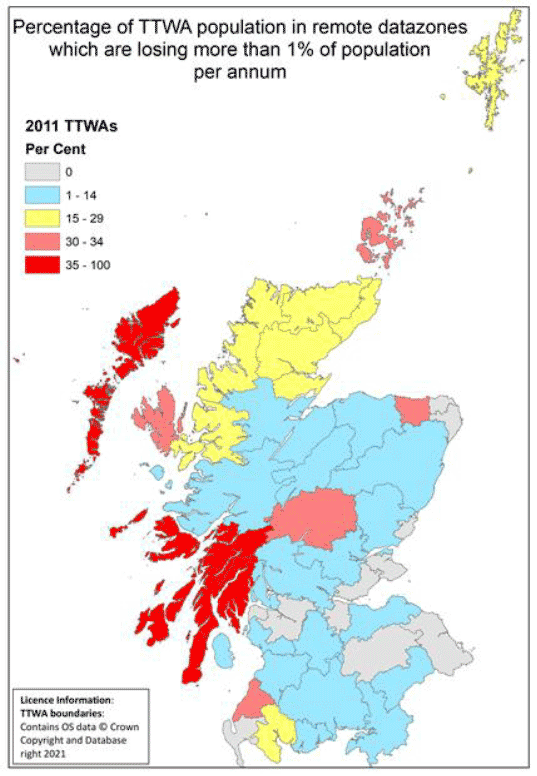
Source: EAG calculations, based on NRS Small Area Population Estimates
Contact
Email: population@gov.scot
There is a problem
Thanks for your feedback